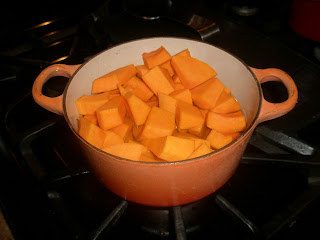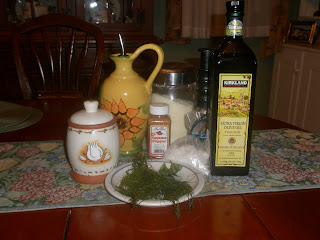MACARONI WITH WINTER SQUASH
I want to share a savory winter recipe this time that is quite unusual but quick and easy to whip up on a cold winter night. It is a traditional Neapolitan pasta dish using sweet, pureed yellow winter squash. I do not think you will see it anywhere else: I have searched.
THE SQUASH CONTEST:
 |
| Varieties of Squash: Butternut, Sweet Potato Squash, Acorn |
BUTTERNUT SQUASH
The butternut is oblong, or pear shaped, with a long throat and bulbous end, and has a pale light beige exterior. It is hard as a rock but because the outside is smooth it is fairly easy to peel, remove the seeds, and cut into cubes. It cooks in water to a soft consistency in a very short time. The flesh is a rich, creamy bright orange-yellow and maintains its color once cooked. It is very sweet but not cloying.
SWEET POTATO SQUASH
This variety was highly recommended by the vendor at the Saratoga Farmer's Market, where I bought the other two varieties. The skin is bright yellow with green or orange stripes. It was easy to peel, and the flesh was very pale. The seed cavity ran the whole length of the squash. It cooks very quickly. I found the flesh to be very potatoey once cooked...not very sweet. It would probably jazz up mashed potatoes but in this recipe, it left a lot to be desired. Farmer's Market people, wrong!!
 |
| Notice the difference in color: Top: Butternut. Bottom: Sweet Potato |
 |
| Acorn Squash |
THE WINNER:
Which squash won? The butternut, of course! Looks count for something, and it is so delicious. You need not only the sweet taste but you also need that sunny yellow color!
Here is the recipe:
MACARONI WITH WINTER SQUASH
Ingredients:
 |
1 large butternut squash
1 lb any shape pasta, such as ziti, gemelli, or even spaghetti
2 cloves garlic, sliced
water
1/2 cup low sodium chicken broth (optional)
1 tbs canola oil
1 tsp extra virgin olive oil for taste*
butter (optional)
salt
pepper
Grated romano pecorino cheese
Chopped fresh parsley
- Peel the squash using a downward motion, then cut it in half lengthwise. Made sure you remove all the peel down to the flesh. Scoop out the seeds and stringy material and discard. Cut it into small cubes and place them into a pot of boiling water. Cook until tender, 5 to 8 minutes. Drain and place into a bowl, and mash with a fork or potato masher. Set aside.
- Boil water for pasta and cook according to package directions.
- Into a cold saucepan, place canola oil and garlic, and cook on a medium flame for a minute or two and do not brown, or it will be bitter. Place squash mixture in pan, and stir, taking care as it may sputter due to its thickness. You may add the low sodium chicken broth, a bit at a time, until it is a smoother, looser consistency. Add salt and pepper to taste. If you want, you can add the teaspoon of oil and a bit of butter. Taste as you go!!
- Drain pasta when it is al dente. Place either in individual dishes or one large bowl, and top with enough sauce to coat the pasta well. Top with grated cheese and parsley. It is a rich, sweet and savory dish, toasty warm and perfect for a winter's day.

 |
| This is what the sauce will look like when done |
 |
| Finished! |
http://www.nytimes.com/2010/11/17/dining/17curious.html?_r=1&scp=3&sq=olive%20oil%20loses%20taste&st=cse
This is a busy season, and sometimes I am too busy cooking to write about it! However, I do look forward to sharing more of my dishes with you, and I especially look forward to reading your comments, which is easier to do as now you do not have to sign in any more. I also appreciate it if you sign up as a Follower or Friend.
Enjoy the season, and remember the reason!






